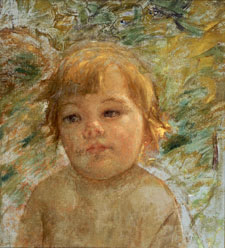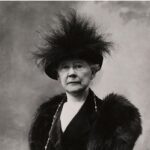
Mary Cassatt
American, 1844-1926 (active France)
The Blond Baby (Bébé Blond), 1875 ca.
oil on canvas, laid on board
14 5/8 x 13 3/8 in.
SBMA, Gift of Dwight and Winifred Vedder
2006.54.2

Mary Cassatt, Archives of American Art, Smithsonian Institution
•" I have not done what I wanted to, but I tried to make a good fight."
-Mary Cassatt
• Degas to Mary Cassatt: Most women paint as though they are trimming hats. Not you.
• Edourd Degas about Mary Cassatt: I don't admit that a woman draws that well!
RESEARCH PAPER
The Artist
Mary Cassatt was an American artist, a close friend of Edgar Degas and a member of the group of painters known as the Impressionists. She lived and worked in Paris almost all of her adult life. She was not married and had no children; however she surrounded herself with family. Her parents and sister lived with her in Paris. She was born in 1844 in Allegheny City (now a part of Pittsburgh), Pennsylvania. She grew up in Philadelphia, the daughter of an affluent investment banker. The family was well-to-do and from the upper class. Their life in Paris was one of culture and gentility.
Cassatt had a conventional course of study at the Pennsylvania Academy of Art before moving to Paris. There, since women were not permitted to attend the official art schools, she studied mostly on her own, copying the Old Masters in museums as well as traveling to Italy, Spain, and Belgium for the same purpose.
Cassatt left Europe during the Franco-Prussian War (1870-1871), returning to Philadelphia. When the war ended she went back to Europe and her studies. None of the strife of wartime is portrayed in her work.
Cassatt's paintings reflected domestic life of the upper class in Paris. Most of her works were done indoors, her most common subject being that of women and children, usually one woman holding a baby, reminiscent of Madonna and Child scenes of earlier periods. The outstanding characteristic of these paintings is the unaffected individuality of each face, relaxed, un-posed women whose faces expressed very real feelings, subtle emotion. The distinction here is that former artists treated the subject of mother and child with sentimentality and glory as if being a mother was all about saintliness and perfection. Cassatt's subjects were very real people with whom we, the viewers, can easily empathize.
Cassatt was a strong, independent woman, highly opinionated, and very much her own person. She generously supported the women's suffrage movement.
Cassatt was mentored by Degas and became special friends with him even though many people think Degas was a misogynist. He was astounded that a woman could paint with such amazing skill and convey such remarkable psychological expression. In spite of this they mutually admired one another's talent and were longtime friends. Together they were part of the group of painters in Paris at that time who broke away from the mainstream to do their own thing--the Impressionists. Cassatt disliked the term impressionism and referred to her colleagues as "Independents". She was offended when her work (one that Degas had given her some pointers on!) was refused by the Salon, the mainstream exhibition in Paris at that time. From that time on she turned her back on the Salon and all future competitions and prizes. Though Cassatt was later offered prizes she refused them out of principle, rebelling against all jury and judging systems. She felt the judges were stupid and politically prejudiced.
Cassatt worked in oil, pastels, and print making. She was very impressed and influenced by the newly introduced Japanese woodblock prints popular in Europe during that time. She developed her own unique technique for making prints and wrote a treatise detailing each step of her special process. As far as is known, no one has tried to duplicate her way of making prints.
Cassatt's subject matter was almost entirely that of women close to her. Often her sister or a young female relative or friend or maid or neighbor child would be portrayed in her parlor concentrating on her needlework, or a couple of friends would be having tea, or be seen dressed up and seated in the loge of an opera house waiting for the opera to begin. There are a very few paintings of men and those that are happen to be of her brother and nephew.
When her brother passed away in 1911 she was very distraught and stopped painting for 2 years. In 1914 the cataracts that had been bothering her for several years took over and she was left blind. Though she wasn't able to paint the last 12 years of her life, and suffered the loss of beloved family, she was able to get around the familiar rooms of her home and garden and receive visitors.
The Art
Bébé Blond is oil on canvas laid down on board, most likely done in the 1880's.
What is most striking about this work is the baby's expression. It is typical of Cassatt's other works in that we can see this little boy is thinking about something; he looks a little off to the side and even though the point of view is straight on he doesn't face us. He is not posed as a subject was traditionally posed, rather the impression is that he just happens to be there and Cassatt is "taking his snapshot". The baby is not idealized; he is a child like many we've known. We get a glimpse of him in an ordinary moment simply being himself. His hair is not combed, he's probably just out of the bath, his mother perhaps reaching for his clothes outside the range of the picture after having toweled him dry.
In most of Cassatt's works she places her subject in a background of domestic comfort. There is often decorative wallpaper, interesting patterns in the fabric of furniture and rugs. She frequently places a mirror in the background reflecting another view of the subject. However, here, in Bébé Blond , the background is obscure. It brings the focus right to the child's eyes so we wonder what he may be seeing and thinking. The background is a lovely subtle mix of many pastel colors creating a warm setting, giving the impression of comfort and security. The many colors mixed as they are here are typical of a technique of the Impressionists, that is, using many small strokes of paint working together to give an impression of something or a feeling. The influence of Degas in his use of pastels, sketchy brushstrokes and use of color, as well as the casual pose wonderfully capturing the baby's personality, can all be seen here.
Often the colors represent light reflecting off a surface thereby creating a mood. The mood here is calm and restful. Cassatt uses white in strategic spots ---notice it on the baby's nose, upper cheek, and over one eyebrow. This touch of white, insinuating reflection of light, creates an aura of our being present in the very moment of this scene.
The circular shape of the child's face is repeated in the soft curvature of his shoulders. We see it again in the roundness on his little nose right in the center. This is a very simple portrait, however it embodies much of what Mary Cassatt's works conveyed throughout her career. It is a picture of charming domesticity, a private scene of maternal life, relaxed and unsentimental.
Bébé Blond , or The Blond Baby , has been gifted to the Santa Barbara Museum of Art as part of the Vedder Collection. It was labeled circa 1875; however having compared it to other works by Cassatt of that time, it was more likely done at a later period, matching more closely the style of her works of the 1880's.
Prepared for SBMA Docent Council by Gina Chalmers, 2007.
Bibliography
Cassatt and Her Circle * Selected Letters. Edited by Nancy Mowll Mathews. Abbeville Press, New York, 1984
Costantino, Maria. Mary Cassatt. Barnes & Noble, Inc., 1995
Getlein, Frank. Mary Cassatt Paintings and Prints. Abbeville Press, New York, 1980
Mathews, Nancy Mowll. Mary Cassatt. Harry N. Abrams, Inc. Publishers, New York. In association with The National Museum of American Art, Smithsonian Institution, 1987
Sister Wendy Beckett. The Story of Painting
DK Publishing in association with the National Gallery of Art, Washington, D.C., Second American Edition, 2000
WebMuseum, Paris. http://www.ibiblio.org/wm/paint/auth/cassatt
Nicholas Pioch, Aug 19, 2002
